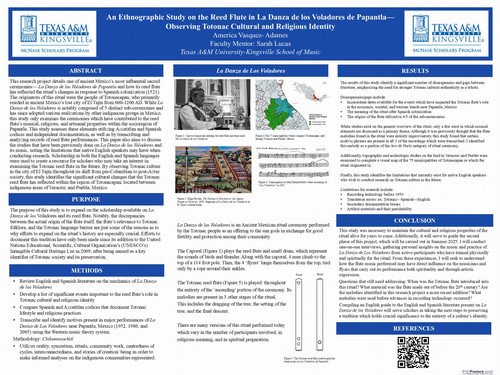This research paper will detail one of ancient Mexico’s most influential sacred ceremonies— La Danza de los Voladores de Papantla and how its reed flute has reflected the ritual’s changes in response to Spanish colonization (1521). The most widely acclaimed practitioners of this ritual were the Totonac people, who primarily resided in Mexico’s city of El Tajín from 300-1200 AD.1 Numerous ancient practices like La Danza de los Voladores can be traced back to El Tajín’s excavation site. While the overall ritual is composed of five sub-ceremonies and has since adopted various realizations originated by other indigenous groups in Mexico, this study only examines the Totonac ceremonies which have contributed to the reed flute’s musical, religious, and artisanal properties within Papantla, Mexico. I will assess these elements utilizing existing studies on this ritual, Azcatitlan and Spanish codices, independent documentation written during colonization, and the transcription and analyses of three distinct records of reed flute performances using the Western music theory system. Scholarship in both the English and Spanish languages was used to create a resource for scholars who may take an interest in examining the reed flute in the future. Additionally, this paper aims to discuss the studies that have been previously done on La Danza de los Voladores, noting the limitations that native English speakers may have when conducting research, and to offer an English language summary of the available sources on the topic so that broader group researchers may have access to the information. By observing Totonac culture in Papantla throughout its shift from pre-Columbian to post-Aztec society, this study intends to identify the significant changes that the reed flute has undergone within the socioregion of Totonacapan; located in indigenous areas of Veracruz and Puebla, Mexico.
Faculty Mentor: Dr. Sarah Lucas
School of Music


